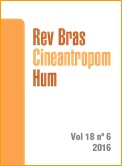Projeto Esporte Brasil: physical fitness profile related to sport performance of children and adolescents
DOI:
https://doi.org/10.1590/1980-0037.2016v18n6p658Abstract
The aim of this study was to outline the physical fitness profile related to sport performance of Brazilian children and adolescents, stratified by sex. This is a descriptive cross-sectional study and information was obtained from the Projeto Esporte Brasil (PROESP-Br). The sample consisted of 8,750 voluntary subjects aged 7-17 years evaluated in the period between 2013 and 2015. The following variables were evaluated: lower limb strength (LLS) through the horizontal jump test and upper limb strength (ULS) through mediceball pitch, speed through the 20-meter sprint test and agility through the square test. Variables were classified with PROESP-Br criteria. For data processing, means, standard deviations, absolute and relative frequencies and confidence intervals were used. The results for boys have shown that the “poor” category had the highest prevalence: LLS (40.2%), ULS (29.7%), speed (41.4%) and agility (37.5%). The “excellent” category, as expected, had the lowest prevalence: LLS (3.7%), ULS (4.9%), speed (2.0%) and speed (3.5%). The results for girls were similar to those of boys, where the “poor” category had the highest prevalence: LLS (43.7%), ULS (36.8%), speed (43.8%) and agility (41.0 %). The “excellent” category also had the lowest prevalence: LLS (4.2%), ULS (4.3%), speed (1.6%) and speed (3.1%). The results indicated that the majority of Brazilian children and adolescents have physical fitness related to sport performance. Among variables analyzed, LLS for girls and speed for boys were the components with the most unfavorable results.



